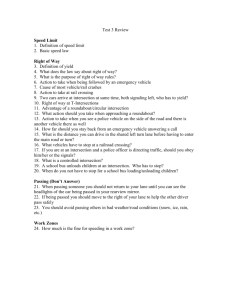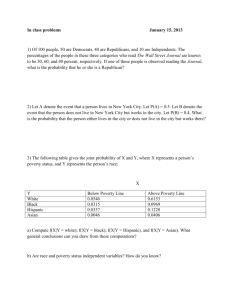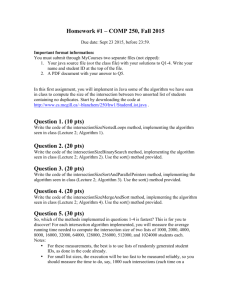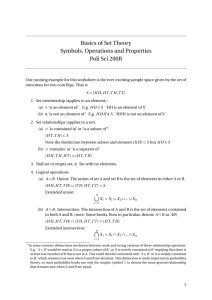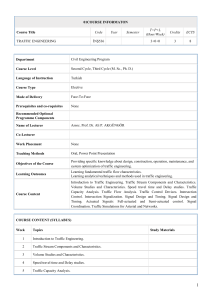NAME: DUE DATE:______ UNIT 3 HOMEWORK PACKET (chapters
advertisement
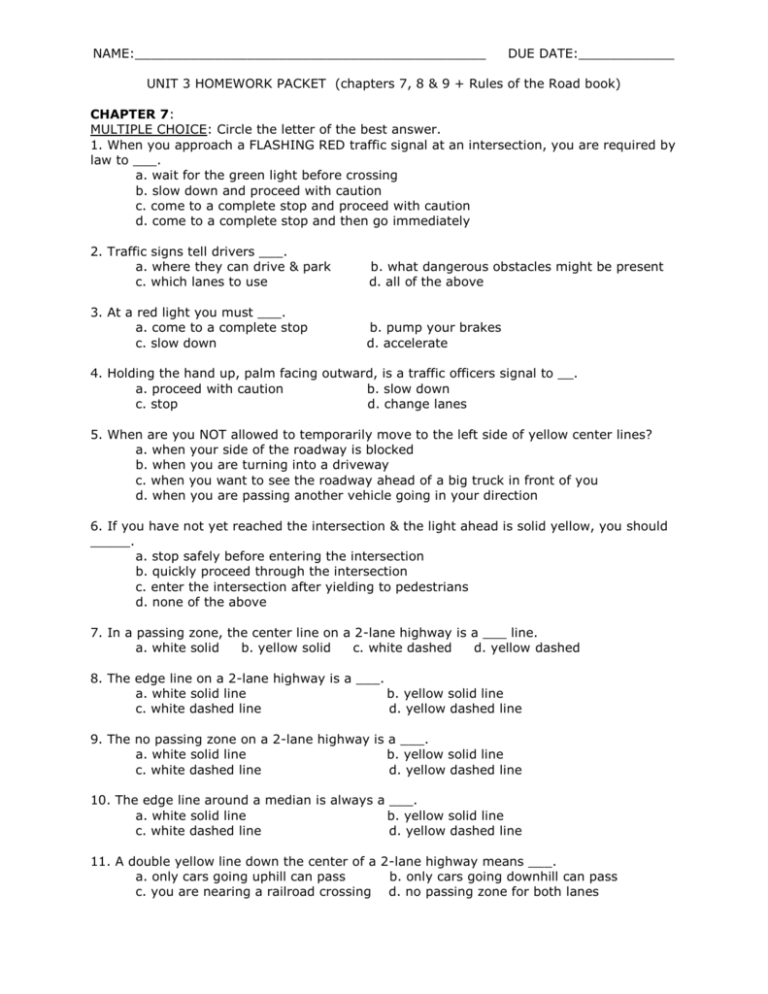
NAME:____________________________________________ DUE DATE:____________ UNIT 3 HOMEWORK PACKET (chapters 7, 8 & 9 + Rules of the Road book) CHAPTER 7: MULTIPLE CHOICE: Circle the letter of the best answer. 1. When you approach a FLASHING RED traffic signal at an intersection, you are required by law to ___. a. wait for the green light before crossing b. slow down and proceed with caution c. come to a complete stop and proceed with caution d. come to a complete stop and then go immediately 2. Traffic signs tell drivers ___. a. where they can drive & park c. which lanes to use b. what dangerous obstacles might be present d. all of the above 3. At a red light you must ___. a. come to a complete stop c. slow down b. pump your brakes d. accelerate 4. Holding the hand up, palm facing outward, is a traffic officers signal to __. a. proceed with caution b. slow down c. stop d. change lanes 5. When are you NOT allowed to temporarily move to the left side of yellow center lines? a. when your side of the roadway is blocked b. when you are turning into a driveway c. when you want to see the roadway ahead of a big truck in front of you d. when you are passing another vehicle going in your direction 6. If you have not yet reached the intersection & the light ahead is solid yellow, you should _____. a. stop safely before entering the intersection b. quickly proceed through the intersection c. enter the intersection after yielding to pedestrians d. none of the above 7. In a passing zone, the center line on a 2-lane highway is a ___ line. a. white solid b. yellow solid c. white dashed d. yellow dashed 8. The edge line on a 2-lane highway is a ___. a. white solid line b. yellow solid line c. white dashed line d. yellow dashed line 9. The no passing zone on a 2-lane highway is a ___. a. white solid line b. yellow solid line c. white dashed line d. yellow dashed line 10. The edge line around a median is always a ___. a. white solid line b. yellow solid line c. white dashed line d. yellow dashed line 11. A double yellow line down the center of a 2-lane highway means ___. a. only cars going uphill can pass b. only cars going downhill can pass c. you are nearing a railroad crossing d. no passing zone for both lanes 12. a. side road b. merging c. keep to the right d. reduction of lanes a. side road b. merging c. keep to the right d. reduction of lanes 13. 14. a. yield b. no passing c. stop a. yield b. no passing c. railroad d. slow moving vehicle 15. d. slow moving vehicle 16. a. merging c. divided highway ends b. keep to the right d. divided highway begins a. workers ahead c. pedestrian crossing 17. b. school crossing d. park 18. a. yield b. no passing c. railroad d. slow moving vehicle 19. a. state highway b. interstate highway c. county highway d. regulatory MATCHING: For each of the following sections, match the letter with the word or phrase that best fits the definition. TYPES OF SIGNS A. Guide Sign B. Regulatory Sign C. Warning Sign 20. _____ type of sign that alerts you to possible hazards ahead, a change in road conditions, or upcoming intersection or pedestrian crossing 21. _____ type of sign that tells you where you are, where you are going, or how to get somewhere 22. _____ type of sign that tells you what you can or cannot do at certain times and places A. Black / White D. Green 23. 24. 25. 26. 27. 28. 29. _____ _____ _____ _____ _____ _____ _____ COLORS B. Blue E. Orange G. Yellow C. Brown F. Red construction warning service signs (gas, food, lodging) cultural interest / recreation stop, yield, wrong way, do not enter where you are, where are you going regulatory signs (speed limit, one-way) RULES OF THE ROAD BOOK: MULTIPLE CHOICE: Circle the letter of the best answer. 30. On school days when children are present, the school zone speed limit is ___. a. 30 mph b. 25 mph c. 20 mph d. 15 mph 31. You are NOT required to stop for a school bus which has stopped to load or discharge children when on a ___. a. 2-lane highway & overtaking the bus from the rear b. 4-lane highway & overtaking the bus from the rear c. 4-lane highway & approaching the bus from the opposite direction d. 1-way street & overtaking the bus from the rear 32. A learner’s permit is valid ___. a. for 6 months c. until a 3rd attempt is made for a license b. for 2 years d. an unlimited period of time 33. If you are a minor & want to become an organ donor, you ___. a. must have permission from a next of kin b. don’t need permission c. must be at least 21 years old d. none of the above 34. In order to practice driving using your instruction permit, you should ___. a. have a licensed driver in the car with you b. have a licensed parent beside you c. have a person beside you who has been licensed for at least 1 year, has parental permission & is at least 21 years old d. both b & c are correct 35. You must hold your instruction permit for ___ before you are eligible to apply for a drivers license. a. 3 months b. 6 months c. 9 months d. 12 months 36. You have just had an accident. You must ___. a. set the blame for the accident before notifying the police b. withhold all information until the police arrive c. give required information to the other person involved; name, address, phone number, driver’s license number, license plate number & insurance information d. discuss information with the other driver to determine who was at fault 37. If you are a first offender of the Zero Tolerance law, ___. a. your driving privileges will be suspended for 3 months for registering any alcohol level above .00 b. your driving privileges will be suspended for 6 months for refusal or failure to complete a BAC test c. you can be arrested for having any trace of alcohol in your system d. all of the above are true 38. If you are under the age of 21 and refuse to submit to a BAC test, your license will be ___. a. revoked b. suspended for at least 6 months c. suspended for at least 2 years d. none of the above 39. According to the Graduated Licensing System, if you are convicted of a second moving violation during the Initial Licensing Phase (16-17 years of age), your license will be ___. a. revoked b. suspended until age 18 c. suspended a minimum of 30 days d. valid, but a letter will be sent to your parent or guardian 40. If a crash involves death, bodily injury or property damage over $500, a report must be made ___. a. to the police and the Illinois Department of Transportation b. only to the other owner c. to the Secretary of State d. to your Driver Education teacher 41. What should a driver do when approaching a traffic control signal that is not in operation (not working)? a. come to a full stop and yield the right-of-way before entering the intersection b. if the intersection is clear, the driver does not need to stop c. drive quickly through the intersection to get out of the way of other vehicles d. none of the above TRUE / FALSE: Read the following statements. If it is a true statement, circle the word true; if it is false, circle the word false. 42. True or False Drivers who have vision restrictions noted on their driver’s license must always wear glasses or contacts when driving. 43. True or False During the Initial Licensing Phase, a teen driver is allowed only two passengers under age 20 in the vehicle during the first 12 months of licensing. 44. True or False In order to obtain court supervision for a traffic violation, a minor must appear in court with a parent/legal guardian and attend a traffic safety school. 45. True or False A parent or legal guardian may request that the driver’s license of a minor be cancelled at any time prior to age 18. 46. True or False When an authorized vehicle using its sirens and flashing lights approaches a vehicle, the driver should pull to the right-hand edge of the roadway and wait for the emergency vehicle to pass. 47. True or False A merge sign means drivers should be prepared to change lanes or allow other traffic to come into their lane. 48. True or False When approaching a stop sign that is not marked by a crosswalk, drivers should stop their vehicles before entering the intersection. 49. True or False An orange sign means drivers should be alert, adjust their speed and be prepared to stop if necessary. CHAPTER 8: MULTIPLE CHOICE: Circle the letter of the best answer. 50. If a traffic signal light turns from green to yellow as you reach the intersection, you are required by law to ___. a. stop immediately and then proceed with caution b. stop partially in the intersection if necessary and back up c. blast your horn and accelerate rapidly d. stop under control 51. A driver approaches a stop sign at an intersection. There are white pedestrian crossing lines at this intersection before the stop sign. The driver should stop the car ___. a. a few feet short of the stop sign b. even with the stop sign c. shortly before entering the intersection d. a few feet short of the pedestrian crossing lines 52. An intersection that has signals or signs to assign the right of way is called ___. a. a protected intersection b. an unprotected intersection c. a controlled intersection c. an uncontrolled intersection 53. You should approach an uncontrolled intersection with cross traffic in the same way as you approach a ___. a. four-way stop sign b. construction sign c. warning sign d. yield sign 54. You are approaching an intersection with a sign at one approach. The intersection is ___. a. semi-controlled b. unprotected c. protected d. uncontrolled 55. An intersection that has neither traffic signs nor traffic signals is ___. a. an unprotected intersection b. an uncontrolled intersection c. a semi-controlled intersection d. a controlled intersection 56. Clues that help to identify an intersection ahead are ___. a. street signs and street lights b. solid or broken white lines c. approaching vehicles from the front and rear d. orange traffic signs 57. If two vehicles approach an uncontrolled intersection at the same time, ___. a. the driver on the left has the right of way b. the driver on the right has the right of way c. the driver on the left yields when turning d. the driver on the right yields when turning 58. Upon the approach of an oncoming emergency vehicle sounding a siren or flashing a red light, the law requires a driver to ___. a. stop immediately wherever you are b. steer right and maintain speed c. increase your speed to get out of the way d. steer right, cautiously slow down and, if necessary, stop 59. ___ must stop at railroad crossings. a. School buses carrying children c. Vehicles carrying hazardous materials b. Trucks carrying flammable material d. All of the above 60. When entering a street or highway from an alley or private driveway, you ___. a. do not have to stop unless you need to yield to oncoming traffic b. do not have to stop unless you need to yield to pedestrians in the sidewalk c. you are legally required to stop just short of the roadway d. none of the above 61. Your chance of having a collision at an intersection is ___. a. relatively small b. greater than at any other place c. impossible d. unknown 62. When you are in an intersection waiting to make a left turn, when the light turns red you should ___. a. back up b. drive straight through the intersection c. proceed cautiously when oncoming traffic has stopped d. stay where you are & wait for the next green light 63. When approaching an intersection, always look ___. a. right, left, ahead, and right again b. ahead, left, right and left again c. left, right, ahead and left again d. left, ahead, right and left again 64. To yield means to ___. a. give another person the right of way b. wait for a green light c. let another person give you the right of way d. insist on taking the right of way 65. If it is your right of way at an intersection, you should ___. a. make sure that nobody else tries to move before you b. yield to all the others c. insist on proceeding first d. proceed only when others are yielding to you 66. More than half of all train car collisions are caused by ___. a. driver error b. trains jumping the tracks c. light/gate malfunctions d. none of the above TRUE / FALSE: Read the following statements. If it is a true statement, circle the word true; if it is false, circle the word false. 67. True or False You are required by law to give up the right-of-way if you have the last clear chance of avoiding a crash. 68. True or False If you face a YIELD sign at an intersection, you must always come to a complete stop. 69. True or False When entering a roadway from a private driveway with a crosswalk, you must stop once for pedestrian traffic and a second time for vehicular traffic. 70. True or False A controlled RR crossing has lights & gates; an uncontrolled RR crossing only has lights. 71. True or False It’s okay to stop your vehicle on the RR tracks for a short time while waiting for the vehicle in front of you to proceed. 72. True or False Always slow down, look and listen before crossing a RR intersection; crossing signals and gates can sometimes break. CHAPTER 9: MULTIPLE CHOICE: Circle the letter of the best answer. 73. You intend to turn left at an intersection. Others will yield the right of way to you for a left turn only when the ___. a. light is red b. light is flashing red c. light is green d. left-turn arrow is green 74. Turning right on red after stopping is allowed ___. a. at all intersections b. except when entering a one-way street c. at intersections except where signs prohibit it d. only during daylight hours 75. If left turns are allowed after a left-turn arrow ends, the strategy you should use to complete the turn is to ___. a. assume oncoming traffic yields to you b. turn left ahead of other traffic c. stop before the intersection d. treat it as an unprotected left turn 76. An intersection with a left-turn light, a green arrow, or a delayed green light has a. a protected left turn b. an unprotected left turn c. a semi-controlled left turn d. a semi-protected left turn 77. A three point turnabout would be most appropriate ___. a. on a dead-end street b. in light traffic c. on a four lane roadway d. on a one-way street 78. ___ requires backing. a. pulling into a driveway on the left c. a three point turn b. a U-turn d. pulling into a driveway on the right 79. As you slow down to prepare for a right turn, you should ___. a. tap your brakes to indicated your intentions to drivers behind you b. move to the shoulder of the road c. activate your turn signal & depress the clutch d. turn on your hazard lights TRUE / FALSE: Read the following statements. If it is a true statement, circle the word true; if it is false, circle the word false. 80. True or False When you are making an unprotected left turn, oncoming traffic must yield to you. 81. True or False Driver miscommunication is a major factor in many crashes. 82. True or False When adjusting your speed to turn left or right, you should look at the sharpness of the turn; the sharper the turn, the slower you should be driving. 83. True or False It is legal to cross solid double-yellow lines to get around traffic and get into the turn lane. 84. True or False A two-point turn is a type of turnabout that requires the use of a driveway, intersection or alley. 85. True or False A three-point turn is a type of turnabout that should be done on a rural road, in a residential area with no driveways, on a dead-end street, or in an emergency.
